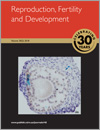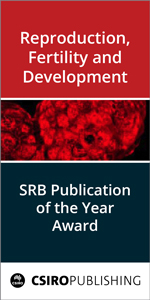Reproduction, Fertility and Development
Volume 30
Number 2 2018
Juvenile in vitro embryo transfer (JIVET) can increase the genetic gain rate by reducing the generation interval, but the low quality of the oocytes and higher oxidative levels leads to poor embryo production. In the present study we hypothesised that melatonin could be a suitable tool for improving oocyte competence in juvenile goats. The results show that melatonin is present in the follicular fluid in juvenile goats and its addition to the in vitro maturation medium reduces oxidation and increases embryo development showing its potential role for JIVET.
Hormones in plants may provide an important trigger for activating breeding activity in Kākāpō, a critically endangered New Zealand parrot. By comparing native and Australian parrots for their ability to respond to steroid hormones, we discovered novel sequences in the receptivity of parrots to oestrogenic compounds. Receptor modeling revealed that altered interactions with plant oestrogens in parrots may enhance the physiological pathways linked to fertility and successful breeding.
The zona pellucida (ZP) is an extracellular matrix formed by few glycoproteins that covers the oocyte and plays an important role during fertilisation. The identification of ZP glycoproteins in carnivores is relevant for an understanding of sperm–ZP interactions and species specificity. In this study, molecular and in silico analyses demonstrated the presence of the ZP1 gene in four families (Felidae, Mustelidae, Odobenidae and Ursidae), whereas in three families (Canidae, Otariidae and Phocidae) ZP1 is pseudogenised. This information could be relevant for the development of more specific and efficient contraceptive vaccines for carnivores.
Juvenile in vitro embryo transfer (JIVET) can increase the gain rate by reducing the generation interval, but the low quality of these oocytes leads to poor embryo production. In this study we hypothesised that oocyte quality could be related to omega 3 (linolenic acid, ALA) and omega 6 (linoleic acid, LA) concentrations in follicular fluid. No differences were found in ALA and LA concentrations in relation to follicle diameter. The addition of a high LA (omega 6) concentration to the IVM medium impaired oocyte competence to develop up to the blastocyst stage.
Equine immature oocytes are classified as expanded or compact and are matured in the laboratory to obtain offspring; higher maturation rates are reported for expanded oocytes. The aim of this study was to assess whether differences in the maturation capacity of these oocytes is related to differences in glucose uptake, metabolism or apoptosis. Consistent metabolic and genomic differences were found between expanded and compact oocytes: compact oocytes consumed more glucose but matured less than expanded oocytes. This indicates that the maturation requirements vary for compact and expanded oocytes.
Taking advantages of the clustered regularly interspaced short palindromic repeat (CRISPR)/CRISPR-associated (Cas) 9 system, we achieved a precise single-nucleotide substitution in the growth differentiation factor 9 (GDF9) gene using a single-stranded oligo deoxynucleotide as a homology-dependent repair template with a relatively high efficiency in order to increase litter size in goats. The present study provides an alternative approach for introducing defined point mutations in large animal models for the improvement of significant traits, as well as for the functional validation of key variants.
Inflammation plays an important role in the initiation of preterm birth, which remains the largest cause of neonatal deaths. In the present study, components of the protein synthesis machinery were significantly increased with labouring compared to non-labouring fetal membranes and myometrium, and blockade of protein synthesis significantly reduced inflammation in the myometrium. These results may provide further insight into the pathways involved in the initiation of preterm birth.
Toll-like receptors (TLRs) contribute to an exclusive protection system in the uterus during the oestrus cycle; however, the importance of TLRs in tissue repair within the involuting uterus is not known. Herein we show that TLRs are constitutively expressed in uterine cells and that the localisation pattern of TLRs in the endometrium varies with structural changes in the involuting uterus. These results suggest that TLRs have a physiological role in the uterine remodelling events during the post partum involution period.
The testis is the organ essential for spermatogenesis and male fertility. This paper profiles differences in DNA methylation levels during prepubertal porcine testis development, and provides new insights into mammalian testis development and represents a foundation for additional research using the pig as a model animal.
In vitro growth of secondary follicles isolated from the vitrified ovarian cortex allows a better understanding of their complex development and of obtaining healthy follicles. The aim of this study was to investigate how the medium composition affects the viability and growth rate of the isolated secondary follicles. This technique could become a strategy to preserve the reproductive potential of females.
Assisted reproduction techniques such as in vitro fertilisation and embryo culture have been shown to affect the size and anatomy of the newborn and the placenta in some species, but no information is available on this area in the horse. We evaluated foals and placentas from pregnancies resulting from natural conception, embryo transfer and transfer of in vitro-produced (intracytoplasmic sperm injection) embryos and found no significant differences between groups in size or weight of the foal or placenta and no differences in expression of 17 genes controlling placental function. Our findings suggest that the horse embryo differs from that of ruminants in its sensitivity to the in vitro environment, supporting the continued use of assisted reproduction techniques for commercial foal production.
It is not known whether female accessory reproductive organs that play a major role in reproduction are vulnerable to chronic stress effects. This study revealed irreversible oxidative stress in the Fallopian tube following short or long-term chronic stress exposure, whereas uterus changes were reversible following short-term exposure but not after long-term exposure. This study indicates that stress-induced reproductive failure may also be due to alterations in the accessory reproductive organs.
Fertilisation and development of the mammalian egg is still not well understood, illustrated by low efficiencies of assisted reproductive technologies. The role of a cell membrane receptor for calcium (CASR) was studied, using pig spermatozoa and eggs as models. Significant effects were demonstrated by stimulating this receptor at different steps of the process. These findings are useful for future basic and applied research.
Although giant pandas have been described as mono-oestrus spring breeders, males exposed to oestrous females outside this timeframe exhibit breeding behaviours and interest in mating. Urinary androgens and sperm parameters were quantified for males exposed to females expressing oestrus during spring, autumn, or winter. The data from this study showed a rapid physiological readiness of male giant pandas to mate in response to female oestrous cues within or outside of the normal breeding season and may suggest a facultative seasonal reproduction with a “female-induced rut”.
Extravillous trophoblast cells are one of the main elements that are affected by maternal smoking during pregnancy. Quantitative changes in extravillous trophoblast cells could be evidence for the hypothesis that changes in these cells could affect fetal health by changes in normal placentation.




